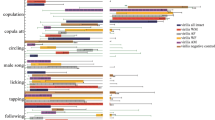Abstract
Geographic variation in courtship vibratory signals inLipara lucens from 7 disjunctive European populations were examined. Simple female responding signals showed significant interlocal difference in the pulse-group intervals only in the English population. More differentiated male courtship signals were separated into anterior “preliminary vibration” and posterior “main vibration”. The latter, composed of a train of bursts, showed significant differences among populations in the number of pulses in a burst, burst duration (BD), burst interval (BI) and burst period (BP). Latvian, Hungarian and Bulgarian populations had more pulses in a burst than those of E. Germany, Belgium, Czechoslovakia and England. Latvian and Bulgarian populations showed significantly larger values of BD, whereas that of Belgium showed a significantly smaller value. BI in the English population had the smallest value, and those in the Latvian and Bulgarian populations had the longest values. No significant differences were observed in BD and BI between E. Germany, Czechoslovakia and Hungary. Multivariate statistic analyses on the time-amplitude variables of the male signals showed uniqueness in the Belgian, English, Latvian and Bulgarian populations. Genetic background of the geographic variations in the vibratory signals are discussed in this context.
Similar content being viewed by others
References
Booij, C. J. H. 1982 Biosystematics of theMuellerianella complex (Homoptera, Delphacidae), interspecific and geographic variation in acoustic behaviour.Zeitschr. Tierpsych. 58: 31–52.
Bush, G. L. 1975 Models of animal speciation.Ann. Rev. Ecol. Syst. 6: 339–364.
Carson, H. L. 1985 Genetic variation in a courtship-related male character inDrosophila silvestris from a single Hawaiian locality.Evolution 39: 786–686.
Chvála, M., J. Doskocil, J. H. Mook & V. Pokorny 1974 The genusLipara Meigen (Diptera, Chloropidae), systematics, morphology, behaviour, and ecology.Tijdschr. Ent. 117: 1–25.
Claridge, M. F., J. D. Hollander & J. C. Morgan 1985 Variation in courtship signals and hybridization between geographically definable populations of the rice brown planthopper,Nilaparvata lugens (Stal).Biol. J. Linn. Soc. 24: 35–49.
Hoy, R. R. 1974 Genetic control of acoustic behavior in crickets.Amer. Zool. 14: 1067–1080.
Ikeda, H., I. Takabatake & N. Sawada 1980 Variation in courtship sounds among three geographical strains ofDrosophila mercatorum.Behavior Genetics 10: 361–375.
Kanmiya, K. 1981a Life ofLipara species.Insectarium 18: 140–148. (In Japanese).
Kanmiya, K. 1981b Mating behavior in the genusLipara Meigen: Mutual communication by transmission of substrate vibration of the reed stem. I:Insectarium 18: 224–229 (In Japanese).
Kanmiya, K. 1981c Mating behavior in the genusLipara Meigen: Mutual communication by transmission of substrate vibration of the reed stem. II.Insectarium 18: 260–267 (In Japanese).
Kanmiya, K. 1982 The Japanese species of the genusLipara Meigen (Diptera, Chloropidae), with descriptions of three new species and a new record.Kurume Univ. J. 31: 37–55.
Kanmiya, K. 1984 Phylogeny ofLipara based on biological evidence.XVII Int. Congr. Ent., Abst.: 36.
Kanmiya, K. 1986 Speciation of the genusLipara-Life-form and mating behavior. pp. 66–76. In,Biogeography in Japan (S. Kimoto ed.). Tokai Univ. Press, Tokyo. (In Japanese).
Kanmiya, K. 1989 Study on the speciation of the worldLipara species based on the mating signals. Unofficial report of Kurume Univ., 60 pp. (In Japanese).
Lande, R. 1980 Genetic variation and phenotypic evolution during allopatric speciationAm. Nat. 116: 463–479.
Mayr, E. 1963Animal Species and Evolution. Cambridge, Mass., Harvard Univ. Press.
Mayr, E. 1970Population, Species and Evolution. Cambridge, Mass., Harvard Univ. Press.
Mook, J. H. & C. G. Bruggemann 1968 Acoustical communication byLipara lucens (Diptera, Chloropidae).Ent. exp. & appl. 11: 397–402.
Nakao, S. & K. Kanmiya 1988 Acoustic analysis of the calling songs of a cicada,Meimuna kuroiwae matsumura in Nansei Islands, Japan. Par. I. Physical properties of the sound.Kurume Univ. J. 37: 25–45. (In Japanese with English summary).
Paterson, H. E. 1978 More evidence against speciation by reinforcement.S. Afr. J. Sci. 74: 369–371.
Perdeck, A. G. 1958 The isolating value of specific song patterns in two sibling species of grasshoppers (Chorthippus brunneus Thunb. andC. biguttulus L.).Behaviour 12: 1–75.
Rupprecht, R. 1972 Dialektbildung bei den Trommelsignalen vonDiura (Plecoptera).Oikos 23: 410–412.
Templeton, A. R. 1981 Mechanisms of speciation—A population genetic approach.Ann. Rev. Ecol. Syst. 12: 23–48.
Wright, S. 1932 Character change, speciation, and the higher taxa.Evolution 36: 427–443.
Author information
Authors and Affiliations
About this article
Cite this article
Kanmiya, K. Acoustic properties and geographic variation in the vibratory courtship signals of the european chloropid fly,Lipara lucens meigen (Diptera, Chloropidae). J. Ethol. 8, 105–120 (1990). https://doi.org/10.1007/BF02350281
Received:
Accepted:
Issue Date:
DOI: https://doi.org/10.1007/BF02350281




